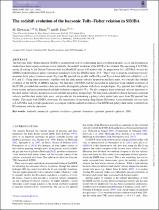| dc.contributor.author | Glowacki, M | |
| dc.contributor.author | Elson, E | |
| dc.contributor.author | Dav´e, R | |
| dc.date.accessioned | 2022-08-01T09:53:53Z | |
| dc.date.available | 2022-08-01T09:53:53Z | |
| dc.date.issued | 2021 | |
| dc.identifier.citation | Glowacki, M., Elson, E., & Davé, R. (2021). The redshift evolution of the baryonic tully-fisher relation in SIMBA. Monthly Notices of the Royal Astronomical Society, 507(3), 3267-3284. doi:10.1093/mnras/stab2279 | en_US |
| dc.identifier.issn | 3267–3284 | |
| dc.identifier.uri | https://doi.org/10.1093/mnras/stab2279 | |
| dc.identifier.uri | http://hdl.handle.net/10566/7647 | |
| dc.description.abstract | The baryonic Tully–Fisher relation (BTFR) is an important tool for constraining galaxy evolution models. As 21-cm HI emission
studies have been largely restricted to low redshifts, the redshift evolution of the BTFR is less studied. The upcoming LADUMA
survey (Looking At the Distant Universe with the MeerKAT Array) will address this. As preparation for LADUMA, we use the
SIMBA hydrodynamical galaxy formation simulation from the SIMBA-hires (25 h
−1Mpc)3 run to generate rotational velocity
measures from galaxy rotation curves (Vflat) and HI spectral line profile widths (W50 and W20) at three different redshifts (z = 0,
0.5, and 1). Using these measures, together with the dark matter velocity dispersion and halo mass, we consider the redshift
evolution of the BTFR of SIMBA galaxies. We find that LADUMA will be successful in detecting weak redshift evolution of
the BTFR, provided that auxiliary data are used to distinguish galaxies with discy morphologies. W20 spectral line widths give
lower scatter and more pronounced redshift evolution compared to W50. We also compare these rotational velocity measures to
the dark matter velocity dispersion across redshift and galaxy morphology. We find weak redshift evolution between rotational
velocity and the dark matter halo mass, and provide fits for estimating a galaxy’s dark matter halo mass from HI spectral line
widths. This study with SIMBA showcases the importance of upcoming, deep Square Kilometre Array pathfinder surveys such
as LADUMA, and provides predictions to compare with the redshift evolution of the BTFR and galaxy dark matter content from
HI rotational velocity measures. | en_US |
| dc.language.iso | en | en_US |
| dc.publisher | Oxford university press | en_US |
| dc.subject | methods: numerical | en_US |
| dc.subject | Galaxies: ISM | en_US |
| dc.subject | Galaxies: evolution | en_US |
| dc.subject | Galaxies: general | en_US |
| dc.subject | Galaxies: formation | en_US |
| dc.subject | Methods: numerical | en_US |
| dc.title | The redshift evolution of the baryonic Tully-Fisher relation in SIMBA | en_US |
| dc.type | Article | en_US |

